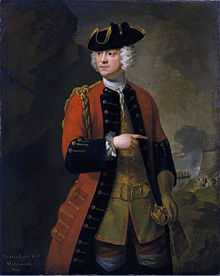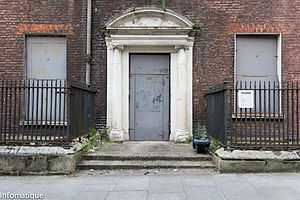Richard Molesworth, 3rd Viscount Molesworth
| The Viscount Molesworth | |
|---|---|
 Richard Molesworth, 3rd Viscount Molesworth | |
| Born |
1680 Swords, Dublin |
| Died |
12 October 1758 (aged 77 or 78) London, England |
| Buried at | Kensington, London |
| Allegiance |
|
| Service/branch |
|
| Years of service | 1702–1758 |
| Rank | Field Marshal |
| Commands held | Commander-in-Chief, Ireland |
| Battles/wars |
War of the Spanish Succession Jacobite rising of 1715 |
Field Marshal Richard Molesworth, 3rd Viscount Molesworth, PC (1680 – 12 October 1758), styled The Honourable Richard Molesworth from 1716 to 1726, was an Anglo-Irish military officer, politician and nobleman. He served with his regiment at the Battle of Blenheim before being appointed aide-de-camp to the Duke of Marlborough during the War of the Spanish Succession. During the Battle of Ramillies Molesworth offered Marlborough his own horse after Marlborough fell from the saddle. Molesworth then recovered his master's charger and slipped away: by these actions he saved his master's life. Molesworth went on Lieutenant of the Ordnance in Ireland and was wounded at the Battle of Preston during the Jacobite rising of 1715 before becoming Master-General of the Ordnance in Ireland and then Commander-in-Chief, Ireland.
Military career
Born the youger son of Robert Molesworth, 1st Viscount Molesworth and Letitia Molesworth (née Coote, daughter of Richard Coote, Lord Coloony), Molesworth abandoned his legal studies and was commissioned as an ensign in Orkney's Regiment on 14 April 1702.[1]
Promoted to captain, Molesworth served with his regiment at the Battle of Blenheim in August 1704, before being appointed aide-de-camp to the Duke of Marlborough on 22 May 1706 during the War of the Spanish Succession.[2] During the Battle of Ramillies, which took place the following day, Molesworth offered Marlborough his own horse after Marlborough fell from the saddle.[2] Molesworth then recovered his master's charger and slipped away: by these actions he saved his master's life.[2] Promoted to captain in the Coldstream Guards and lieutenant colonel in the Army on 5 May 1707, he was present at the relief of Brussels in 1708 and at the Battle of Malplaquet in September 1709 and was wounded by a mine at the Siege of Mons in October 1709.[2] He commanded an infantry regiment in Catalonia under the Duke of Argyll from July 1710 until he returned to England in late 1712.[2]
Molesworth became Lieutenant of the Ordnance in Ireland in December 1714 and was elected Member of Parliament in the Irish House of Commons for Swords in 1715.[2] He raised a regiment of Dragoons in 1715 and was wounded at the Battle of Preston in November 1715 during the Jacobite rising of that year.[2] After taking part in the competition to develop a marine chronometer, he was elected a Fellow of the Royal Society in March 1722.[3]
Molesworth became colonel of the Inniskilling Regiment of Foot in March 1725 and succeeded his brother as 3rd Viscount Molesworth on 17 February 1726.[4] He went on to be colonel of the Viscount Molesworth's Regiment of Dragoons in May 1732 and, having been promoted to major-general on 18 December 1735[5] and appointed a Lord Justice for Ireland in December 1736, he became colonel of the 5th Regiment of Dragoons in June 1737.[6] Promoted to the local rank of lieutenant-general in Ireland in 1739, he became Master-General of the Ordnance in Ireland in 1740.[4] Promoted to the substantive rank of lieutenant-general on 1 July 1742 and to general of the horse on 24 March 1746,[7] he became Commander-in-Chief, Ireland in September 1751.[4] At this time he lived at 14 Henrietta Street in Dublin.[8]
Promoted to field marshal on 3 December 1757,[9] Molesworth became Governor of the Royal Hospital Kilmainham; he died in London on 12 October 1758 and was buried in Kensington.[4]

14 Henrietta Street Dublin August 2011
Family
Molesworth first married Jane Lucas; they had one child, Mary, who became the second wife of Robert Rochfort, 1st Earl of Belvedere.[10] Following the death of his first wife he married Mary Jenney Usher on 7 February 1744 and had four children from this union; Henrietta, Melosina, Mary and Louisa (who married William Ponsonby, 1st Baron Ponsonby).[11]
References
- ↑ "Richard Molesworth, 3rd Viscount Molesworth". Oxford Dictionary of National Biography. Retrieved 20 July 2014.
- ↑ 2.0 2.1 2.2 2.3 2.4 2.5 2.6 Heathcote, p. 211
- ↑ "Library and Archive Catalogue". Royal Society. Retrieved 20 July 2014.
- ↑ 4.0 4.1 4.2 4.3 Heathcote, p. 212
- ↑ The London Gazette: no. 7464. p. 1. 16 December 1735. Retrieved 20 July 2014.
- ↑ The London Gazette: no. 7614. p. 2.a. 28 June 1737. Retrieved 20 July 2014.
- ↑ The London Gazette: no. 8625. p. 2. 21 March 1746. Retrieved 20 July 2014.
- ↑ "Henrietta Street Conservation Plan". Dublin City Council. p. 17. Retrieved 20 July 2014.
- ↑ The London Gazette: no. 9744. p. 1. 29 November 1757. Retrieved 20 July 2014.
- ↑ Cokayne, G.E. (2000). The Complete Peerage of England, Scotland, Ireland, Great Britain and the United Kingdom, Extant, Extinct or Dormant, new ed., volume II. Alan Sutton Publishing. p. 114.
- ↑ Cokayne, G.E. (2000). The Complete Peerage of England, Scotland, Ireland, Great Britain and the United Kingdom, Extant, Extinct or Dormant, new ed., volume X. Alan Sutton Publishing. p. 576.
Sources
- Heathcote, Tony (1999). The British Field Marshals 1736-1997. Pen & Sword Books Ltd. ISBN 0-85052-696-5.
| Parliament of Ireland | ||
|---|---|---|
| Preceded by Robert Molesworth Plunket Plunket |
Member of Parliament for Swords 1715–1727 With: Plunket Plunket |
Succeeded by Hon. Bysse Molesworth Edward Bolton |
| Military offices | ||
| Preceded by Thomas Whetham |
Colonel of the Inniskilling Regiment of Foot 1725–1732 |
Succeeded by Archibald Hamilton |
| Preceded by James Crofts |
Colonel of Viscount Molesworth's Regiment of Dragoons 1732–1737 |
Succeeded by John Cope |
| Preceded by Owen Wynne |
Colonel of the 5th Regiment of Dragoons 1737–1758 |
Succeeded by John Mostyn |
| Preceded by Gervais Parker |
Commander-in-Chief, Ireland 1751–1758 |
Succeeded by The Earl of Rothes |
| Peerage of Ireland | ||
| Preceded by John Molesworth |
Viscount Molesworth 1726–1758 |
Succeeded by Richard Molesworth |
|